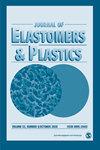Effect of Functionalized MWCNTs with Surfactant and Coupling Agent on Properties of LDPE/POE Blends
IF 1.6
4区 材料科学
Q4 MATERIALS SCIENCE, MULTIDISCIPLINARY
引用次数: 1
Abstract
The surfactant, sodium dodecylbenzenesulfonate (NaDDBS) and coupling agents, γ-aminopropyltriethoxy sliane (KH550) and isopropyl dioleic(dioctylphosphate) titanate (NDZ101) were used to treat multiwalled carbon nanotubes in this work. The effects of surface modification of multiwalled carbon nanotubes on crystallization behavior, mechanical properties, and electrical properties of low density polyethylene/polyolefin elastomer/multiwalled carbon nanotubes composites were studied. The results showed that NaDDBS, KH550, and NDZ101 had a favorable effect of improving the dispersion of multiwalled carbon nanotubes, but it cannot improve the interfacial interactionbetween multiwalled carbon nanotubes and the matrix. The improvement in dispersion favored the crystallization behavior and mechanical properties. Modified multiwalled carbon nanotubes had a better acceleration nucleation effect than raw multiwalled carbon nanotubes on low density polyethylene/polyolefin elastomer blends at low content (≤1 wt%). The tensile strength of low density polyethylene/polyolefin elastomer/multiwalled carbon nanotubes composites with modified multiwalled carbon nanotubes increased with lower multiwalled carbon nanotubes content (≤1 wt%), and KH550 and NDZ101 led low density polyethylene/polyolefin elastomer/multiwalled carbon nanotubes composites to possess a higher tensile strength than that of NaDDBS with 1 wt% content. NaDDBS, KH550, and NDZ101 had a minor influence on the dielectric properties of the composites and even caused a decrease in the dielectric loss of composites with 10 wt% multiwalled carbon nanotubes content.表面活性剂和偶联剂功能化MWCNTs对LDPE/POE共混物性能的影响
采用表面活性剂十二烷基苯磺酸钠(NaDDBS)和偶联剂γ-氨基丙基三乙氧基sliane (KH550)和异丙基二油酸(磷酸二辛基)钛酸盐(NDZ101)处理多壁碳纳米管。研究了多壁碳纳米管表面改性对低密度聚乙烯/聚烯烃弹性体/多壁碳纳米管复合材料结晶行为、力学性能和电性能的影响。结果表明,NaDDBS、KH550和NDZ101对改善多壁碳纳米管的分散性有较好的效果,但不能改善多壁碳纳米管与基体的界面相互作用。分散的改善有利于结晶行为和力学性能。在低密度聚乙烯/聚烯烃共混物中(≤1 wt%),改性多壁碳纳米管比原始多壁碳纳米管具有更好的加速成核效果。改性多壁碳纳米管的低密度聚乙烯/聚烯烃弹性体/多壁碳纳米管复合材料的抗拉强度随着多壁碳纳米管含量的降低(≤1 wt%)而增加,KH550和NDZ101使低密度聚乙烯/聚烯烃弹性体/多壁碳纳米管复合材料的抗拉强度高于1 wt%含量的NaDDBS。NaDDBS、KH550和NDZ101对复合材料的介电性能影响较小,当多壁碳纳米管含量为10 wt%时,复合材料的介电损耗也有所降低。
本文章由计算机程序翻译,如有差异,请以英文原文为准。
求助全文
约1分钟内获得全文
求助全文
来源期刊

Journal of Elastomers and Plastics
工程技术-材料科学:综合
CiteScore
3.30
自引率
5.90%
发文量
41
审稿时长
6 months
期刊介绍:
The Journal of Elastomers and Plastics is a high quality peer-reviewed journal which publishes original research on the development and marketing of elastomers and plastics and the area in between where the characteristics of both extremes are apparent. The journal covers: advances in chemistry, processing, properties and applications; new information on thermoplastic elastomers, reinforced elastomers, natural rubbers, blends and alloys, and fillers and additives.
 求助内容:
求助内容: 应助结果提醒方式:
应助结果提醒方式:


